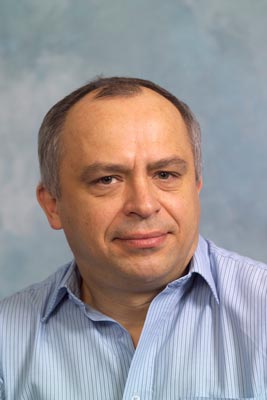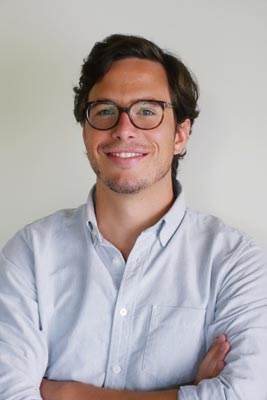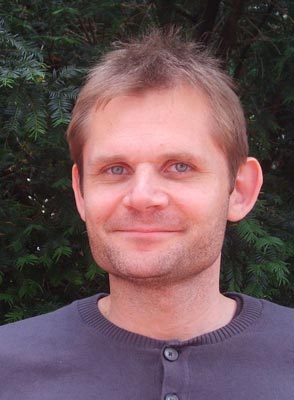December 11, 2014
Three new professors and one new ERC grant
IST Austria President Thomas Henzinger presents successful scientists • Appointments in the new fields solid-state physics and structural biology
This evening, President Thomas A. Henzinger announced the names of three new professors and a further ERC grantee: the solid-state physicists Johannes Fink and Georgios Katsaros, and the structural biologist Leonid Sazanov bring the number of the faculty to 37. The computer scientist Chris Wojtan has been awarded with an ERC Starting Grant for his project “Big Splash: Efficient Simulation of Natural Phenomena at Extremely Large Scales”, resulting in a total number of 15 ERC grantees at IST Austria, of 31 professors currently on campus. (Katsaros also has an ERC Starting Grant, but will arrive only in early 2016.) Henzinger: “The appointments and the ERC grant illustrate the continuing attraction of IST Austria for extraordinarily talented scientists. With experimental solid-state physics and with structural biology the Institute will enter into two important fields of science that are new to IST Austria.”
Johannes Fink is an Austrian physicist born on December 21, 1981, in Bregenz. His main field of research is the interaction of matter and light which he studies using superconducting circuit quantum electrodynamics (QED) and integrated opto- and electro-mechanical devices. After his undergraduate studies at the University of Vienna from 2002 to 2007 he joined the lab of Prof. Andreas Wallraff at ETH Zurich for his master’s thesis and his graduate studies. He managed to observe the geometric phase in an electrical circuit for the first time and continued to work on circuit QED experiments. In his doctoral work he studied a number of important aspects of the resonant interaction between microwave photons and superconducting qubits. One of his major results was the spectroscopic observation of the nonlinear coupling strength of excited photons in a circuit QED system as it was predicted in the 1960ies by the Jaynes-Cummings model for cavity QED. Since 2012 Johannes has been a postdoc with Prof. Oskar Painter at the Institute for Quantum Information and Matter at the California Institute of Technology in Pasadena. Fink will set up his lab at IST Austria as Assistant Professor in early 2016.
Georgios Katsaros is a Greek-German condensed matter physicist, born on September 9, 1976, who is interested in self-assembled semiconductor nanostructures and their electronic transport properties at low temperatures. He studied Physics at the University of Patras (Greece) and then he moved to the National Center For Scientific Research – Demokritos in Athens (Greece), where he worked on solar cells. For his PhDhe joined the group of Klaus Kern at the MPI for Solid State Research in Stuttgart in 2002 where he worked in the field of surface science. His PhD thesis was focused on the structural properties of so called SiGe Stranski-Krastanov islands which are three-dimensional crystalline quantum dots created by heteroepitaxial growth of Germanium on Silicon substrates.
For his postdoctoral research he changed the field to perform low temperature electronic transport measurements through such SiGe (the elements Silicon and Germanium) semiconductors nanostructures in the group of Silvano De Franceschi at CEA Grenoble; one major result being the realization of the first electronic devices based on this material system. After working as a group leader focusing on the development of new Ge self-assembled nanostructures at the Institute for Integrative Nanosciences, which is part of the Leibniz Institute for Solid State and Materials Research in Dresden, Katsaros in 2012 joined the Johann-Kepler-University in Linz (Upper Austria) as group leader working on low temperature electronic transport through semiconductor nanostructures at the Institute of Semiconductor and Solid State Physics. Katsaros will move to IST Austria as Assistant Professor in early 2016.
Leonid Sazanov, a Belarusian-British structural biologist, born on October 20, 1960, studied biophysics (B.Sc. and M.Sc.) at the Belarusian State University in Minsk and performed his doctoral studies at the Department of Biophysics at the Moscow State University where he remained as a research fellow in the group of Sergei V. Zaitsev till 1992. After continuing his research in groups at the University of Birmingham and at Imperial College in London Sazanov joined as a research associate the group of Nobel Laureate John E. Walker at the MRC Laboratory of Molecular Biology in Cambridge. Since 2000 he is at the MRC Mitochondrial Biology Unit in Cambridge where he has been a Tenured Program Leader since 2006.
Sazanov’s research aims to understand the structure and function of membrane proteins and focuses on the determination of the structure of the very large protein assembly respiratory complex I. This complex I plays a central role in cellular respiration and energy metabolism. Mutations in individual subunits can lead to several severe human disorders. In his recent work he could first determine the atomic structure of the hydrophilic domain, then of the membrane domain. Finally, his work led to the determination of the first atomic structure of the entire complex I, the largest asymmetric membrane protein assembly solved to date. Sazanov will join IST Austria as Professor in April 2015.
Chris Wojtan joined IST Austria in February 2011. The Assistant Professor combines mathematical methods from computational physics with geometric techniques from computer graphics. A key contribution of his group is the efficient treatment of topological changes with deforming meshes that split and merge, in order to simulate highly detailed surface tension phenomena, such as the formation of water droplets and splashes. This method is used for the realistic animation of flowing and splashing water. The ERC Starting Grant is funded with € 1,5 mio for five years and will start in 2015.






